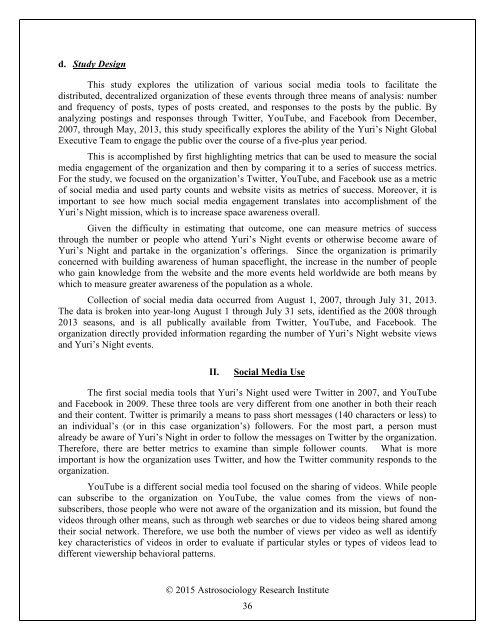THE JOURNAL OF ASTROSOCIOLOGY VOLUME 1
qd9nb3s
qd9nb3s
- No tags were found...
Create successful ePaper yourself
Turn your PDF publications into a flip-book with our unique Google optimized e-Paper software.
d. Study DesignThis study explores the utilization of various social media tools to facilitate thedistributed, decentralized organization of these events through three means of analysis: numberand frequency of posts, types of posts created, and responses to the posts by the public. Byanalyzing postings and responses through Twitter, YouTube, and Facebook from December,2007, through May, 2013, this study specifically explores the ability of the Yuri’s Night GlobalExecutive Team to engage the public over the course of a five-plus year period.This is accomplished by first highlighting metrics that can be used to measure the socialmedia engagement of the organization and then by comparing it to a series of success metrics.For the study, we focused on the organization’s Twitter, YouTube, and Facebook use as a metricof social media and used party counts and website visits as metrics of success. Moreover, it isimportant to see how much social media engagement translates into accomplishment of theYuri’s Night mission, which is to increase space awareness overall.Given the difficulty in estimating that outcome, one can measure metrics of successthrough the number or people who attend Yuri’s Night events or otherwise become aware ofYuri’s Night and partake in the organization’s offerings. Since the organization is primarilyconcerned with building awareness of human spaceflight, the increase in the number of peoplewho gain knowledge from the website and the more events held worldwide are both means bywhich to measure greater awareness of the population as a whole.Collection of social media data occurred from August 1, 2007, through July 31, 2013.The data is broken into year-long August 1 through July 31 sets, identified as the 2008 through2013 seasons, and is all publically available from Twitter, YouTube, and Facebook. Theorganization directly provided information regarding the number of Yuri’s Night website viewsand Yuri’s Night events.II.Social Media UseThe first social media tools that Yuri’s Night used were Twitter in 2007, and YouTubeand Facebook in 2009. These three tools are very different from one another in both their reachand their content. Twitter is primarily a means to pass short messages (140 characters or less) toan individual’s (or in this case organization’s) followers. For the most part, a person mustalready be aware of Yuri’s Night in order to follow the messages on Twitter by the organization.Therefore, there are better metrics to examine than simple follower counts. What is moreimportant is how the organization uses Twitter, and how the Twitter community responds to theorganization.YouTube is a different social media tool focused on the sharing of videos. While peoplecan subscribe to the organization on YouTube, the value comes from the views of nonsubscribers,those people who were not aware of the organization and its mission, but found thevideos through other means, such as through web searches or due to videos being shared amongtheir social network. Therefore, we use both the number of views per video as well as identifykey characteristics of videos in order to evaluate if particular styles or types of videos lead todifferent viewership behavioral patterns.© 2015 Astrosociology Research Institute36


